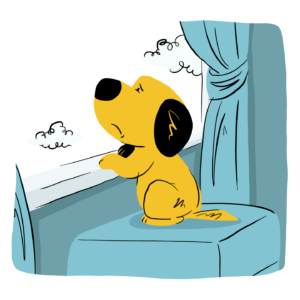Pets and Their People Blog
Separation Anxiety in Puppies and Dogs
Is your dog struggling to be left on their own? Do you wish you knew how to help them feel better when you’re not there?
Prevention of Separation Anxiety in Puppies
Puppies are not designed to be on their own. Every inch of them wants to be with a carer for their survival. Once we understand that bit, it helps us move on with their alone training.
Here are our top tips to help prevent Separation Anxiety in puppies:
- Don’t leave your puppy to cry it out. They won’t just get over it, and will usually increase the distress that then leads to anxiety. Make them feel safe and secure, and that you won’t leave them before they’re ready.
- Have your puppy sleep next to your bed at night, you can let them out to the toilet easier when you hear them wake up and shuffle around, or you can reassure them in the night when they wake up and call out for you. Sometimes a sniff of your hand and a gentle voice is all they need to go back to sleep and relax.
- When your puppy is eating their meals, move around a bit, so that you’re not always static. They might follow, but that’s ok, just be boring. They’ll soon go back to their bowl when they know nothing fun is going to happen with you.
- Use food puzzles and stuffed chew toys to encourage independence and problem solving away from you.
- When you start leaving the room – go for short and sweet popping in and out. No need to make a fuss as you come and go, it should be no big deal to your puppy.
- Plan to practice alone times when your puppy has been exercised, toileted, has something nice to chew on, and is generally a bit snoozy.
- Use a camera to watch them when you’re gone so you know what they’re up to.
- Take it slowly, but keep on doing it, ‘Slow and steady wins the race.’

Help for Dogs with Separation Anxiety
Dogs with Separation Anxiety typically present with any, some, or all of the following when you leave them alone:
- Barking, crying, whining, howling, or another type of vocalization
- Pacing
- Panting
- Drooling
- Destructive behavior such as chewing walls, doors, crates
- Escape attempts – pawing at doors or gates
- Chewing or licking obsessively, sometimes causing sores
Separation Anxiety is a panic disorder. Dogs are not doing it to play up, get back at you for leaving, or control you; they simply don’t know how to cope without you, and panic.
While speaking with a behaviorist or trainer who specializes in Separation Anxiety, such as a CSAT, is typically the best course of action, it is not always an option.
Here are some tips for how to help with your dog’s Separation Anxiety:
- Make sure all of your dog’s needs are being met, that they are getting proper sleep, nutrition, exercise, and opportunity to carry out some breed-specific exercises.
- Get a baseline – set cameras up that can watch your dog from all angles and hit record, sit down for a while, then go through your usual leaving routine.
- Leave for a few minutes, come back and review the footage, at what point did your dog get upset? That’s your starting point, actually start just below it, they were probably feeling a bit worried before you noticed.
- Watch the footage again, sound off, in slow motion – what behaviors do you see in your dog?
- Speak with your veterinarian. They may suggest medication either prescription or over-the-counter. Show them the footage if possible to see how serious this is for your dog.
- If you live somewhere with a lot of sudden noises, see if classical music, talk radio or a brown or pink noise app will help to deaden those bangs and wallops.
- The gold standard for working with dogs with Separation Anxiety is systematic desensitization. We know it’s a mouthful! What it means is gradual exposure to the scary thing (you leaving) – the key word is systematic, keep at it, slow and steady.
- Start with little sessions each day of just under baseline, for some dogs just walking up to the front door is stress-inducing – start working at walking halfway to the door and back again.
- You want your dog to think ‘you come and go, no big deal’ and be reasonably relaxed.
Very few dogs love it when their owner leaves, dogs are social creatures after all, but we can at least help them to cope better, we owe them that don’t we?
About the Author
Petrina Firth is a Dog Trainer and Certified Animal Behaviorist of over 10 years who now mainly specializes in Separation Anxiety (CSAT) and also creates content, lessons and articles for the Zigzag puppy training app and website. Petrina is a member of the PPG, the head of marketing and board member for the APDT UK, and a member of the CAPBT committee. She is also a tech and gadget enthusiast who enjoys city living with her rescue French Bulldog and partner.

* Available in the UK and coming soon to the US.
Zigzag is a Pet Professional Guild Corporate Partner.

